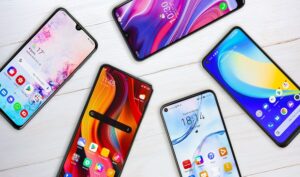6 Best Projectors To Buy This Year: Buying Guide
If you want to know which is the best projectors for you and still learn more about these devices, check out our complete shopping guide, where we present you the best models to use at home, at church, at events, restaurants, and much more.
To get the best possible picture – whether it’s watching HD movies or giving a presentation at work – you will certainly need a good projector to meet your needs.
Projectors have changed a lot over the years and we currently have several categories, specifications, and uses for them. Thinking to help you, this article besides being a guide to buying projectors also has our recommendations of the best projectors available in the market.
Read Also: The 6 Best Mini Projectors To Buy This Year
How to Choose the Right Projector for You
Right away, when faced with so many specifications, complicated acronyms, and names that are difficult to pronounce, we can easily be scared.
To avoid this, we divide the subjects into categories and talk about the main topics that will be useful for you to choose the best projector individually, avoiding generating confusion and doubts.
The Different Uses for Projectors
To start, the best thing to do is to define the use that will be given to your projector. Thus, we separate the most common uses given to projectors and we will address them below.
- Home Theater Projectors: Ideal for making a Home Cinema and enjoying a good movie with family and friends.
- Corporate Projectors: Widely used in executive meetings or even by teachers in classrooms.
- Portable Projectors: In general, they are cheaper and are also used by teachers or professionals looking for a quick and portable way to make presentations.
If your use is not listed below, send us an email or leave a comment below that we would be happy to help you with.
Home Theater Projectors
This type of projector is ideal for those who literally want to make a cinema in their own home, having images up to 36 times larger than a 50 ″ HDTV.
With an image of this size, your movies and games will certainly be more exciting and will have, in addition to an excellent image quality, a high contrast, with detail in dark colors and good saturation (or degree of purity) of colors.
As this type of projector simulates a cinema environment, they work best in environments where it is possible to control the amount of light that enters the room, coming from outside or even from other areas of the house.
However, it is possible to compensate for the ambient light, choosing a model that has high brightness and investing in a reflective screen, aiming to improve the display quality in the environment.
They are models that have good image quality on large screens and have HDMI ports for easy connection.
It is also worth remembering that projectors of this type have quiet coolers, producing less background noise, which will not disturb your movies or games.
Business Projectors
If your use has a corporate or commercial focus, business projectors will suit your needs very well.
They are also known as multimedia projectors or data display and spreadsheets and their models have more brightness than Home Theater projectors.
They also work very well in meeting rooms or classrooms, where lighting comes from windows and even other rooms in the establishment.
They are designed to display mostly still images, such as graphics or slides, but also work well for displaying videos and entertainment in general.
These projectors have at least one HDMI port to easily connect to your notebook or any other device that allows the transmission of images.
They are also very portable, having a small size and, besides being easy to configure, they also allow the option of wireless projection via wireless or Bluetooth.
Portable Projectors
If portability is the deciding factor for you at the time of purchase, portable projectors will surely meet your needs efficiently.
They are small enough to fit in your backpack and compact enough to hold with just one hand.
Weighing less than 3kg, they are ideal for those who travel frequently and need to take the equipment with them at all times.
These are extremely small devices (compared to home theater models) and are the smallest projectors on the market. Recommended for use in small rooms or presentations for small groups of people.
Types of Projection (or Display)
As we go into this topic, we have to be aware that there are different types of projection found in projectors today and each of them has its advantages and disadvantages.
A good choice is to analyze each one and choose the one that best suits your needs.
As this is not a technical article, we will focus on the characteristics and advantages of each of the types mentioned below.
DLP
Projector models that use DLP technology make use of small micromirrors and a rotating wheel to create and focus on an image.
They have clear images with a good response time, in addition to high color contrast and “blacker blacks and whiter whites”, giving good image quality.
LCD
Because they have no moving parts and carry out adjustment automatically, LCD projectors use liquid crystal displays and, because of this, they are cheaper, however, this type of projection requires constant maintenance of the filter and have less contrast than the others mentioned.
In addition, they have brighter, more detailed images, are quieter and more energy efficient compared to DLP projectors.
LCoS
As a third alternative, we have the LCoS projectors that make use of a liquid crystal display in silicone (an “upgrade” of the LCD displays) and are present only in “high-end” devices, that is, Top of the line devices.
In other words, it is a combination of LCD and DLP projectors, highlighting its positive points, thus having a display that has good brightness, a smooth transition in videos and games, and excellent color saturation.
Brightness
A good start to get into this topic is to understand that the brightness of projectors is measured in lumens and, the more lumens the device has, the brighter the projector will be at a given distance.
It is common for manufacturers to pass two-lumen values at different distances so that it is easier to view and choose a projector that best suits your needs.
In addition, we still find two other specifications that indicate the brightness of a projector. The white brightness, which shows the total amount of white light emitted by the device, and the color brightness, which measures how bright the blue, red, and yellow colors will be projected.
But what do these values tell us in practice?
As a tip, we suggest that for business projectors look for models that have more lumens in general, both for white and color brightness, so that you will have a clearer image even in large, well-lit rooms.
As for Home Theater projectors, it is worth looking for models that have a higher color brightness than the white brightness, as this way the colors of the image will be richer and more detailed. But, for that, it is necessary to have an environment in which it is possible to control the lighting.
Making sure to compare the two brightness values before deciding which projector to buy is critical to finding the right model for you.
Contrast
Image contrast is a measure that quantifies the difference between the darkest and the lightest areas of the image.
Is it difficult to understand? Let us simplify for you
To quantify the contrast of a projector, it is common for manufacturers to use aspect ratio, so when faced with the specifications of the projectors, you will find things like 500: 1, 1000: 1, and so on. For example, a ratio of 1000: 1 indicates that white is a thousand times lighter than black.
Therefore, the greater the contrast of the projector, the greater the variation in colors and details that it can project.
For Home Theater (or cinema) projectors, contrast is very important as it determines the level of detail that the image will have, however, for business models, contrast is not very important, since, as they are more used in bright rooms, the ambient light ends up “muting” the contrast.
Regardless of the model chosen by you, we recommend that you look for projectors that have contrast ratios above 500: 1, because below this value, the images have a quality that is not very satisfactory or very accurate.
Resolution
As with the best smart TVs, the number of pixels that a projector is able to display is what defines its resolution and the more pixels that fit on the screen, the greater the detail and sharpness of the image.
Higher resolutions are very important for cinema projectors that need to display an image with great quality, and, they are not so important for business models that with an HD resolution already do the job smoothly.
These resolutions range from 800 × 600 up to 4K, but as an intermediary that serves most users well, we recommend HD resolution (1280 x 720) or even Full HD (1920 x 1080), varying with the given usage and investment in the equipment.
Connections: Ports and Entrances
As one of the last topics to be covered in this article, but no less important than the others, we will address the connectivity options available on the projectors.
It is essential to analyze the connections and ports available for connection when purchasing your equipment.
These ports vary from projector to projector, but in general, we find the following options on most models: HDMI, VGA, USB, DVI.
We still find additional inputs like some extra ports for audio and video, ethernet inputs, mini-USB to connect directly to your smartphone, and even on some newer models, you can find USB-C inputs.
The point is to see if you have compatible inputs for the projector on your devices and buy the necessary cables to make the connection.
Extra Features
Here are some extra functions that can be the difference when buying your projector.
3D Technology
Widely found in Home Theater projectors, this technology makes it possible to reproduce 3D media, just like in theaters.
In some models this technology is built-in, in others it is necessary to purchase a 3D emitter, which is sold separately.
Wireless Projection
A very good differential for those who make a lot of use of the smartphone to play their videos and photos. With this feature, just keep your device connected to the same wifi network as the projector and this gives you the option to transmit media from your device to the projector.
It is worth saying that for this to work properly, many models require the use of a specific application on your smartphone or notebook.
zoom
It is almost not an extra, since the vast majority of projectors currently have this function (except portable projectors, which often exclude this feature, aiming at greater device portability), but it is a good feature to be mentioned.
With the zoom of the projector lens, it is possible to adjust the image much more easily, without having to move the device everywhere.
Read Also: The 10 Best Game Consoles Of All Time
How to choose the best projectors?
After conducting a lot of research in the area and defining the criteria to be evaluated in the choice (weight, image quality, lighting, contrast, portability, and connectivity), we initially search for the best and most recommended projectors through national and international reviews.
After this step, we filtered our list of 13 projectors, leaving only those that have availability and a price “not very unusual” in the market.
As a result, only our finalist projectors remained, and so we defined which are the best projectors available in the market.
One of the questions that may arise when reading this article is: “Why don’t we have 4K projectors on the list of the best projectors?”
And the answer to that question is quite direct: Price. That’s right, the price of 4K projectors is currently very high and not worth the investment.
There are really very few projectors that support 4K resolution, and those that do are absurdly expensive and therefore do not make it onto our list, as they are simply not worth the price.
Top Best Projectors of 2020
See now which are the projectors with the best image, audio, and connectivity quality that you can find on the market. They are models with specific technologies to set up your home cinema, watch movies, and play games on your PC Gamer or console.
1. BenQ W1700 projector
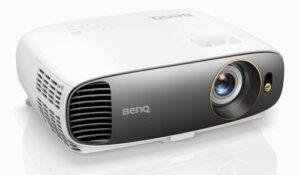
The BenQ W1700 is the Best 4K Projector in our opinion, especially because it has two technologies: CinematicColor, which reinforces the details of the image, and the HDR, which leaves the quality indisputable and hyper-realistic.
The model also corrects colors automatically, according to the brightness of the environment, and has an optimized RGBRGB color wheel. In addition to the standard projection screens, they can be used on large and giant, turning your living room or TV into a real cinema.
Altogether, BenQ has two HDMI inputs, 1 Mini B, one for USB, and the normal audio and video.
Its image resolution is 3840 × 2160 pixels, with the possibility of zoom without loss of quality, being responsive from 30 to 300 inches.
It is still possible to configure the display mode: bright, vivid, cinema and sport, in addition to the personalized one, created and saved for the user’s taste and needs.
Optional accessories include 3D glasses and spare lamps and is configurable in up to 28 languages.
Projector technical sheet:
- Brightness: 2,200 ANSI lumens
- Contrast: 10,000: 1
- Projection size: 120 to 135 inches
- Native resolution: 3840 x 2160 (4K UHD)
- Connections: HDMI, USB
- Weight: 6.6 kg
2. Epson Home Cinema Projector 3100

The Epson Home Cinema Projector 3100 is our indication for anyone who wants to transform any environment into a true cinema.
As it has 3,100 lumens of colored and white brightness, its image adapts to a huge variety of lighting types automatically or configured by the user.
Along with the dynamic contrast of 15,000: 1, this feature still allows the details of dark videos to be more visible.
The model has a zoom, adaptable resolution from 30 to 300 inches, and also has a VGA input, two HDMI and two USB, one type A and one type B.
One of the HDMI inputs is compatible with MHL, for connecting smart devices. Thus, you will be able to transmit your favorite contents from your device, such as the smartphone, directly to the projection.
The design was made to make the projector adapt to different positions without losing quality. Therefore, in addition to being used hanging, it can be placed on top of furniture.
Projector technical sheet:
- Brightness: 2,600 lumens
- Contrast: 60,000: 1
- Projection size: up to 300 inches
- Native resolution: 1920 x 1080 (Full HD)
- Connections: HDMI, USB
- Weight: 4.2 kg
Pros
- Remote control, facilitating use and configuration;
- Built-in speaker;
- It is one of the lightest on the market, weighing 2.7 kg.
Cons
- Only available in white.
3. Epson PowerLite U42 + projector
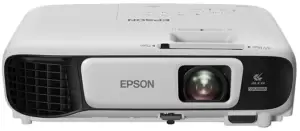
Connection: HDMI, VGA, USB and Wi-Fi | Dimensions (HxWXD): 92 mm x 302 mm x 252 mm | Weight: 2.8 kg | Resolution: 1920 x 1200 pixels (2,304,000 pixels) | Color light output: 3,600 lumens | White light output: 3,600 lumens | Lamp life: up to 6,000 hours (normal) and 10,000 hours (ECO), model 210 W UHE | Keystone correction: Vertical and horizontal -30º + 30º | Contrast ratio: up to 15,000: 1 | Color reproduction: up to 1 billion colors | Warranty: 3 years
With Full HD resolution and main connection via HDMI or Wi-Fi, the Epson PowerLite U42 + was voted Best Projector with Wi-Fi by our team.
First, its projection system with 3 LCD technology with 3 chips provides quality, sharpness, and speed in the transmission of images.
Associated with color reproduction with up to 1 billion tones and a resolution of 1920 x 1200 pixels with 2,304,000 pixels, there is no lack of visual experience.
In fact, wide projections can reach up to 300 inches.
The product is still bivolt, has two HDMI inputs, USB Type-A and B inputs, two mini-stereo RCA audio outputs, a VGA connection and has 3,600 lumens for white or colored light.
Connection to mobile devices can be via HDMI or Wi-Fi, making it ideal for use in domestic environments or in small commercial rooms and offices.
Projector technical sheet:
- Brightness: 3,600 lumens
- Contrast: 15,000: 1
- Projection size: up to 300 inches
- Native resolution: 1920 x 1200 (WUXGA)
- Connections: HDMI, USB, and MHL
- Weight: 2.8 k
Intermediate Projectors
See our most cost-effective projectors. They are models that deliver what they promise and deliver good usability and features for a price range more accessible to the general public. They are our main indications of projectors to use in the church, to make presentations, courses and lectures.
4. LG MiniBeam projector
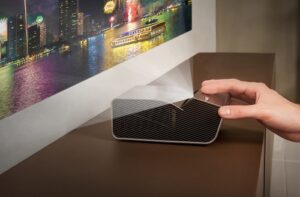
The LG MiniBeam was made for anyone who wants to carry their private cinema wherever they go. Therefore, it is our choice as the Most Portable Projector.
Ideal for offices, TV, or living rooms, the model weighs just 649 g and has all the benefits of similar products, such as Bluetooth, HDMI, and USB input, in addition to a 3D optimizer.
With Bluetooth, for example, you can connect your mobile devices and stream content as much as you want.
Although it is compatible with screens starting at 25 inches, it has a resolution of 1280 × 720, which is not so good for a projector, but it has a good amount of lumens for a portable model (550) and a compatible contrast of 100,000: 1. Thus, the image quality is preserved.
In addition to the items above, the LG MiniBeam features automatic distortion correction (Auto Keystone Vertical) and is recommended as the best mini projector at close range in our article on the best mini projectors.
Projector technical sheet:
- Brightness: 450 lumens
- Contrast: 100,000: 1
- Projection size: 40 to 80 inches
- Native resolution: 1280 x 720 (HD)
- Connections: HDMI, USB, P2
- Weight: 1.1 kg
5. Optoma X343 projector
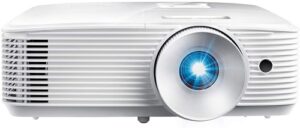
Connection: HDMI, VGA and USB | Dimensions (HxWXD): 24 cm x 31.5 cm x 10 cm | Weight: 3.04 kg | Resolution: 1024 × 768 pixels | Color light output: 3,600 lumens | White light output: 3,600 lumens | Lamp life: up to 15,000 hours (ECO) | Keystone correction: Vertical -30º + 30º | Differential: 10 watt speaker and 1.1x zoom | Contrast ratio: up to 22,000: 1 | Warranty: 1 year
The Optoma X343 is the choice of our team as a Good and Cheap Cinema Projector. With Full HD 3D technology, 1024 × 768 pixel resolution, and 3,600 lumens of colored or white light, it is ideal for small and medium environments.
After all, the screen format is 4:3 and the image size is between 27.7 and 304.4 inches.
In addition, its characteristics make it able to adapt to rooms with too much or too little light.
One of the product’s differentials is the presence of a 10-watt speaker, ideal for presentations. Others are the 1.1x optical zoom and the vertical keystone, which make the device flexible and image correction simple.
Read Also: Top 10 Best Smart TV In–TV Comparison
As for the connection, it also serves well, as it has an HDMI input, a USB, a VGA, in addition to the traditional video and audio outputs.
Projector technical sheet:
- Brightness: 3,600 lumens
- Contrast: 22,000: 1
- Projection size: up to 304 inches
- Native resolution: 1024 x 768
- Connections: HDMI, VGA, and USB
- Weight: 3.04 kg
6. Epson Powerlite S41 + projector

Connection: HDMI, VGA, USB and Bluetooth | Dimensions (AxLXP): 302 mm x 82 mm x 237 mm | Weight: 2.7 kg | Resolution: 800 x 600 pixels (native – 480,000 pixels) | Color light output: 3,300 lumens | White light output: 3,300 lumens | Lamp life: up to 10,000 hours (ECO) 210 W UHE | Keystone correction: Vertical and horizontal -30º + 30º | Contrast ratio: up to 15,000: 1 | Color reproduction: up to 1 billion colors | Warranty: 3 years
However, for those looking for the Best Cheap Projector, our recommendation is for the Epson Powerlite S41+. After all, it is ideal for presentations, common in offices and schools, for example.
With 800 x 600 pixel resolution, 3 LCD image quality technology, and 3,300 lumens of white and color light, it meets these needs well for projections up to 350 inches.
As for the connection, it is compatible with the iProjection app to use the Apple smartphone or iPad and iPod on the screen, it has USB, VGA, and HDMI. However, Wi-Fi can be activated by an optional adapter, purchased separately.
To close, the device is bivolt, has native SVGA, and has an adjustment function and easy installation (Quick Corner), which allows you to adjust the projected image simply and quickly.
Projector technical sheet:
- Brightness: 3,300 ANSI lumens
- Contrast: 15,000: 1
- Projection size: up to 350 inches
- Native resolution: 800 x 600 (4K UHD)
- Connections: HDMI, USB, VGA, and Bluetooth
- Weight: 2.7 kg
Conclusion
We hope this article has helped you to understand more about how projectors work, their main features, and features and such the Best Projectors to buy.
Be sure to comment below if you still have any questions or suggestions for what you want to see here on the blog.

